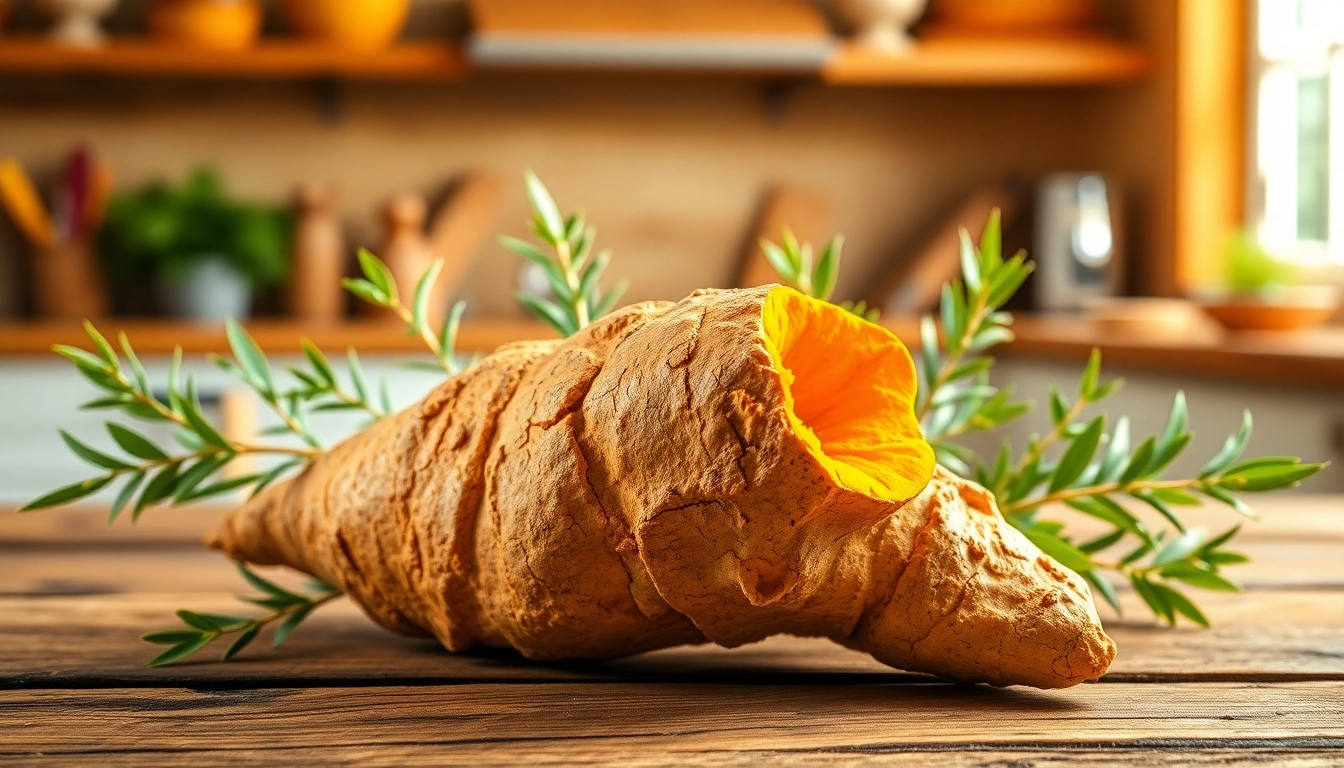
Understanding Turmeric Root
What is Turmeric Root?
Turmeric root, scientifically known as Curcuma longa, is a rhizome belonging to the Zingiberaceae family, making it a cousin to ginger. This vibrant root is characterized by its striking golden-yellow hue and is renowned not only for its culinary applications but also its extensive use in traditional and alternative medicine. The roots are harvested, typically boiled, dried, and ground into a fine powder that serves as a spice and a natural remedy. Turmeric has been utilized for centuries, particularly in Asian cultures, for its flavor and its health-promoting properties. For those interested in sourcing high-quality turmeric root, consider exploring products like those available at Turmeric Root.
Historical Uses in Traditional Medicine
The historical use of turmeric can be traced back to ancient India and China, where it was not only a staple spice but also a key ingredient in Ayurvedic medicine. Turmeric was employed for various ailments, including digestive issues, skin problems, and inflammatory conditions. In Ayurveda, it is known for its ability to balance the doshas (body energies) and is often recommended in herbal formulations. In traditional Chinese medicine, turmeric is utilized to promote blood circulation and alleviate pain. The extensive historical applications highlight turmeric’s significance and its enduring role in holistic health practices.
How Turmeric Root Differs from Other Roots
Turmeric root stands apart from other common roots like ginger and garlic, primarily due to its unique biochemical composition. While ginger is renowned for its anti-nausea properties and garlic for its potent antimicrobial effects, turmeric’s primary bioactive compound, curcumin, is what distinguishes it in terms of health benefits. Curcumin possesses powerful anti-inflammatory and antioxidant properties, making it particularly effective in combating chronic conditions linked to inflammation, such as arthritis and heart disease. Additionally, turmeric root is vibrant in culinary use, imparting a distinct earthy flavor that complements various dishes, unlike many other roots that may possess a more subdued taste.
Health Benefits of Turmeric Root
Anti-Inflammatory Properties Explained
Turmeric’s anti-inflammatory properties are largely attributed to curcumin, which has been extensively studied for its impact on inflammation at a molecular level. Chronic inflammation is recognized as a contributor to various diseases, including heart disease, cancer, and neurodegenerative diseases. Research indicates that curcumin can inhibit molecules that play significant roles in inflammation, thereby potentially alleviating symptoms and reducing the risk of disease onset. For instance, a 2020 study published in the journal Antioxidants highlights curcumin’s ability to reduce inflammatory markers in patients with chronic inflammatory conditions.
Potential Antioxidant Effects
Curcumin also exhibits potent antioxidant effects, which help neutralize free radicals that cause cellular damage. Oxidative stress, resulting from an imbalance between free radicals and antioxidants, is a known factor in aging and the development of various diseases. A study from the University of California, Los Angeles, identified curcumin as effective in scavenging free radicals and enhancing the body’s own antioxidant defenses. This not only supports overall cellular health but potentially protects against age-related changes and the progression of chronic diseases.
Turmeric Root and Digestive Health
In addition to its anti-inflammatory and antioxidant effects, turmeric root is highly regarded for its benefits on digestive health. It has been traditionally used to treat digestive disorders such as bloating, gas, and indigestion. Curcumin stimulates bile production, which aids in fat digestion and absorption. Furthermore, research published in the Journal of Ethnopharmacology suggests turmeric may effectively manage symptoms of irritable bowel syndrome (IBS) and inflammatory bowel diseases (IBD) by reducing inflammation in the gut lining and promoting gut microbiome health.
Culinary Applications of Turmeric Root
How to Incorporate Turmeric Root in Your Diet
Incorporating turmeric root into your diet can be both simple and delicious. Fresh turmeric can be juiced, added to smoothies, or used in various cooking applications. The powder form is versatile and can be used in spice blends, curry dishes, soups, and even teas. Pairing turmeric with black pepper enhances curcumin absorption significantly, making the combination not just flavorful but also health-promoting. Here are a few tips on how to include turmeric root in your daily meals:
- Add grated fresh turmeric to salad dressings for a colorful twist.
- Create a turmeric-infused broth for soups and stews.
- Blend turmeric into smoothies for added health benefits.
- Incorporate it into homemade nut milks for flavor and nutrition.
Delicious Recipes Featuring Turmeric Root
Exploring turmeric root through cooking can unlock its full flavor and health benefits. Here are some recipes that celebrate turmeric’s unique taste:
Golden Turmeric Milk
This soothing beverage combines turmeric with milk (or a plant-based alternative) to create a comforting drink.
Ingredients: - 1 cup milk (or almond milk) - 1 teaspoon grated or powdered turmeric - 1/2 teaspoon black pepper - Honey to taste - Optional spices: cinnamon or ginger Directions: 1. In a small saucepan, heat the milk until warm. 2. Whisk in turmeric, black pepper, and any optional spices. 3. Sweeten with honey to taste before serving warm.
Turmeric Roasted Vegetables
This dish showcases the earthy, aromatic properties of turmeric while making use of seasonal vegetables.
Ingredients: - 2 cups mixed vegetables (cauliflower, carrots, bell peppers) - 2 tablespoons olive oil - 1 teaspoon turmeric - Salt and pepper to taste Directions: 1. Preheat oven to 400°F (200°C). 2. Toss the vegetables with olive oil, turmeric, salt, and pepper in a bowl. 3. Spread on a baking sheet and roast for about 25 minutes until tender.
Complementary Ingredients to Enhance Flavor
Turmeric’s flavor is warm and slightly bitter, making it a great pairing with other spices and ingredients. Consider using:
- Ginger: Offers a spicy kick that pairs well with turmeric in savory dishes and beverages.
- Coconut milk: Its creaminess balances turmeric’s earthiness, rendering delicious curry and soups.
- Lemon: The acidity brightens flavors, making turmeric-based salads and dressings more vibrant.
- Black pepper: Enhances curcumin absorption, thus maximizing turmeric’s health benefits.
Buying and Storing Turmeric Root
Where to Buy Fresh and Dried Turmeric Root
When sourcing turmeric, both fresh and dried forms are widely available in grocery stores and health food markets. Local farmers’ markets may occasionally offer fresh turmeric root, particularly during harvest season. Online retailers provide a variety of options for purchasing dried turmeric, including organic varieties. Check for reputable brands and certifications to ensure quality.
How to Select Quality Turmeric Root
When selecting fresh turmeric root, look for firm, plump pieces with a smooth skin, avoiding any that appear wrinkled or mushy. For dried turmeric, opt for a vibrant orange-yellow color and a strong, earthy aroma. Quality turmeric should have a rich, pungent scent, indicating its potency. Reputable brands often provide information about sourcing and quality-testing, which can be beneficial for consumers.
Best Storage Practices for Freshness
Store fresh turmeric root in a cool, dark place, preferably in a paper bag in the refrigerator to retain moisture and flavor. It can last for several weeks under these conditions. Dried turmeric powder should be sealed in an airtight container and kept in a cool, dark, dry place, like a pantry, to prevent it from losing potency. Use within six months for optimal flavor and benefits.
Turmeric Root in Modern Wellness Practices
Incorporating Turmeric Root into Supplements
Due to its myriad of health benefits, turmeric has gained popularity as a dietary supplement. Many people opt for turmeric capsules or extracts for convenience, particularly for those seeking concentrated doses of curcumin. It’s essential to choose high-quality supplements that contain bioavailable forms of curcumin, often enhanced with black pepper extract (piperine) to increase absorption. Consulting with a healthcare provider before starting any new supplement regimen is advisable.
Scientific Studies Supporting Turmeric Root’s Benefits
Numerous studies have explored the health benefits of turmeric root. Research published in respected journals such as Nutrition Research and Journal of Medicinal Food supports its role in managing conditions like arthritis, metabolic syndrome, and even certain types of cancers due to its anti-inflammatory and antioxidant properties. Ongoing clinical trials continue to investigate the full scope of turmeric’s health potential, affirming its relevance in modern health practices.
Potential Side Effects and Considerations
While turmeric is generally safe for most individuals, high doses or long-term use may lead to side effects. Commonly reported side effects include gastrointestinal discomfort, nausea, and allergic reactions in sensitive individuals. Additionally, turmeric may interact with medications such as blood thinners, so consulting a healthcare provider is essential, especially for those on medication or pregnant. As with any supplement, moderation is key, and recognizing individual tolerance is crucial.







